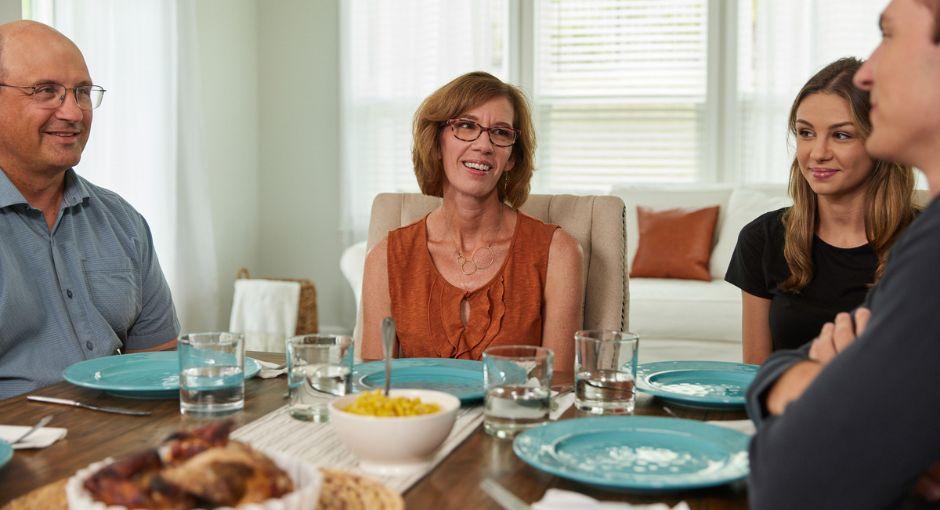Mealtime & Dining Out

Living with Parkinson’s disease (PD) may require adjustments to your mealtime routine. Whether you are cooking and serving meals for yourself or dining out at a restaurant, simple modifications can make the dining experience more enjoyable.
Preparing Meals at Home
PD motor symptoms can make cooking and serving meals a challenge. Use these adaptations to make meals easier to prepare, eat and clean up.
Cooking Appliances and Environment
Arranging your kitchen environment to suit your needs is the first step to making mealtime less of a challenge. Occupational therapists suggest reorganizing the kitchen to place the most commonly used items — such as plates, cups and certain pots — on the counter at a height that is within easy reach.
- In the refrigerator, frequently consumed items should be kept on the middle or top shelves.
- Newer microwaves can be built into cabinets.
- Free up counter space by storing commonly used work surfaces in a cabinet until needed.
Meal Preparation
Planning is key to success in the kitchen. Gather all the ingredients and utensils you might need before you start cooking. This will save energy and reduce the number of trips across the kitchen.
Making modifications to existing tools in your kitchen, or buying adaptive kitchen appliances, can also help simplify the cooking process:
- Build up utensil handles to make them easier to grasp for meal preparation and dining. Use pipe insulation in tube form, found in hardware stores, to easily build up handles.
- Buy a pot stand to help with pouring and mixing. These stands have suction cups on the bottom that stick to the counter.
Care must be taken when cutting during meal prep. Sharp knives can be hazardous, due to tremor that many people with Parkinson’s experience. These tools can help keep you safe:
- Adaptive cutting boards have built-up sides and non-slip backing to help keep items in place when cutting.
- Electric knives are also available and may aid in cutting.
Explore Nutrition and Parkinson's
The right foods will also optimize your medications, keep your bones strong, fight constipation and weight loss and maintain general health and fitness.
Dining
Sitting down to eat a meal can be made easier and more enjoyable by making slight adjustments to your mealtime setting. Stable dining surfaces and easily handled utensils can simplify mealtimes.
- Dycem, a nonstick material, can be cut to size and put under a plate or bowl to keep it from moving on the table.
- Using a plate guard — a one-inch acrylic or metal border that fits on most plates — can make it easier to get food onto your spoon or fork. Push the food up against the guard, and it falls onto the utensil.
There are also many options for adaptive utensils including:
- Utensils with built-up handles and weights.
- Foam pipe insulation can be cut and applied to any utensil.
- Swivel utensils (usually spoons) help avoid spills when scooping up your food.
- Keeping a separate adaptive utensil set to bring to restaurants can make dining out easier.
- Liftware is a newer utensil technology with a stabilizing handle to counteract PD-related tremor and steady the hand. It is available with spoon and fork attachments. While it is a more expensive choice, it can make it easier to scoop up food and bring it to the mouth.
Washing Dishes
People with PD may also consider making modifications to the cleanup portion of the mealtime routine, including:
- Using a dishwashing brush that has soap in them (available at many stores).
- Using a wash mitt to make it easier to grip dishes as you wash them.
- Using the higher rack on the dishwasher to avoid bending down to reach the lower rack.
Going Out to Dinner
Going out to dinner should be an enjoyable experience for everyone. When you are living with PD, planning ahead can prevent unforeseen challenges while dining out. These tips can help you continue to enjoy the pleasure of dining.
Choosing the Restaurant
- Choose restaurants that serve the meal at your table. Buffet-style restaurants requiring that you carry a tray with a dinner plate and a drink can present difficulties or fall risks as Parkinson’s progresses.
- Dine early and time your meal for when your medications are most effective. Most people dine out after 6 p.m. A 5 p.m. arrival allows for quicker seating, faster food service and a more private dining experience.
While these measures are generally accepted as good business practices, the Americans with Disabilities Act (ADA) ensures that no restaurant can deny service to a person with a disability because of the disability or related behaviors.
Page reviewed by Dr. Bhavana Patel, Movement Disorders Neurologist at the University of Florida, a Parkinson’s Foundation Center of Excellence.